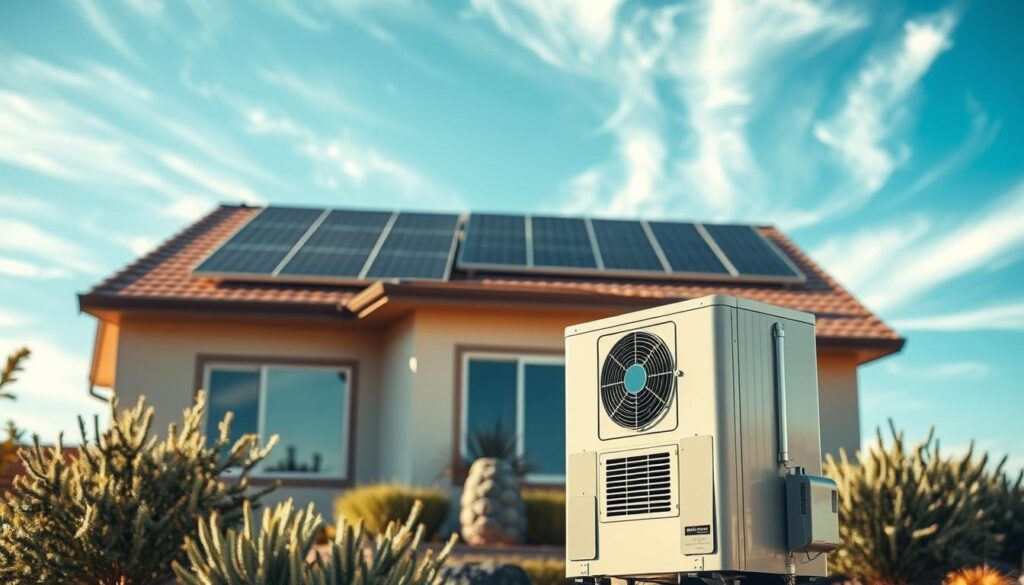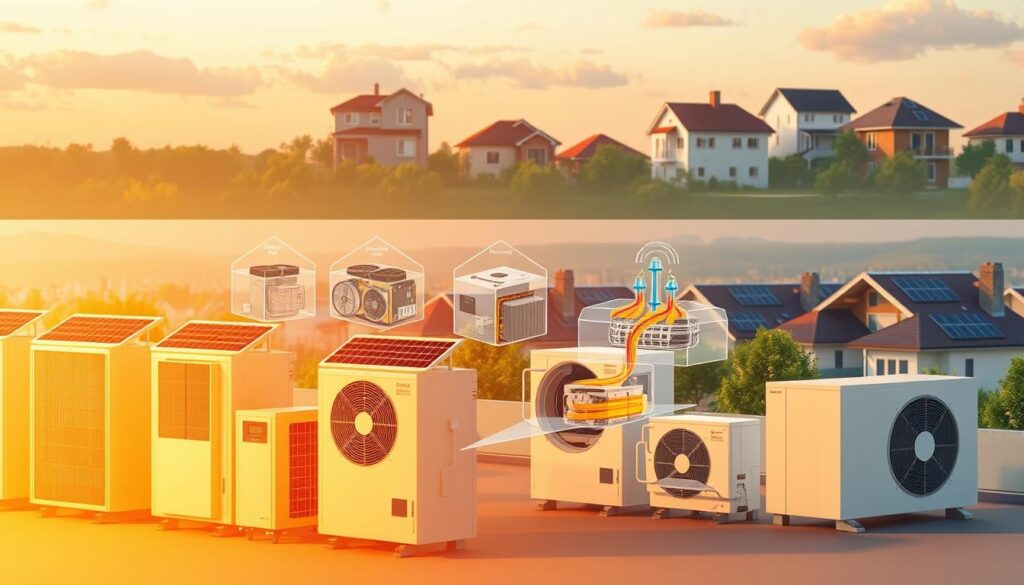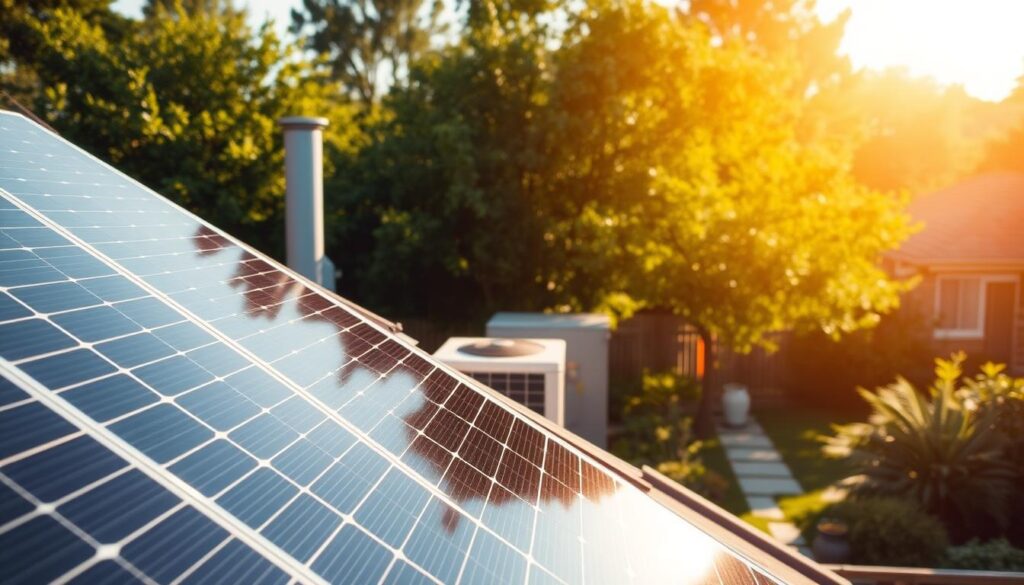Most American homes depend on air conditioning. Over 88% of U.S. households use AC, with higher adoption in regions like the Midwest (92%) and South (93%). This reliance comes at a cost: conventional systems consume 12% of home energy, costing over $29 billion annually and emitting 117 million metric tons of CO2 yearly.
Solar cooling systems offer a cleaner alternative. During summer’s peak sunlight hours, solar panels generate energy to power home solar air conditioners, reducing reliance on traditional electricity. Energy Star-certified systems with SEER ratings of 15 or higher boost efficiency, while innovations like Lennox’s solar-ready units promise up to 50% lower utility bills.
Key Takeaways
- 88% of U.S. homes use AC, contributing to $29 billion in annual energy costs.
- Traditional AC systems release 117 million metric tons of CO2 yearly.
- Solar cooling systems can cut energy bills by up to 50% with optimized setups.
- Solar energy peaks in summer, aligning with highest AC demand periods.
- Energy Star-rated systems improve efficiency with SEER ratings of 15 or higher.
Understanding Home Solar Air Conditioners: How Sun Powers Your Cooling
Home solar air conditioners harness sunlight to cut energy costs and reduce reliance on traditional power. Here’s how solar-powered cooling systems turn sunlight into comfort:
The Basic Science Behind Solar Cooling
Photovoltaic (PV) panels convert sunlight into direct current (DC) electricity. This energy fuels compressors or absorption chillers in air conditioners. Modern systems like the LEZETi solar hybrid achieve a COP of 3.81, turning 885 watts into 11,500 BTU of cooling. Even window units, which typically use 500–1,400 watts, become eco-friendly when paired with solar power.
Components of a Solar-Powered Air Conditioning System
- Solar panels: Capture sunlight (e.g., 320-watt panels for small homes)
- Inverters: Convert DC to alternating current (AC) for most home systems
- Batteries: Store excess energy for nighttime or cloudy days
- AC units: Efficient models like the Pioneer Mini Split (22.5 SEER) use less power
Different Types of Solar Air Conditioning Technologies
Choose from these setups:
- Direct DC systems: Power 750 sq. ft. homes with 700-watt panels
- Hybrid systems: Switch to grid power automatically when solar fades
- Solar thermal: Use heat to drive cooling cycles without electricity
These renewable energy cooling options pair innovation with affordability, making summer comfort sustainable and budget-friendly.
Environmental Benefits of Switching to Solar-Powered Cooling
Traditional air conditioners contribute to climate change by relying on electricity from fossil fuels. Switching to an eco-friendly air conditioner powered by the sun slashes greenhouse gas emissions. Each year, U.S. homes emit 117 million metric tons of CO2 from cooling alone—equivalent to the annual output of 25 million cars. Solar cooling systems cut this pollution at its source.
By replacing grid electricity with sunlight, solar systems reduce demand for coal and gas plants during peak summer hours when air pollution peaks. A single solar-powered unit can offset 3-5 tons of CO2 annually, adding up to major impact when scaled across households. The U.S. Energy Information Administration reports that 6% of all residential energy use goes to cooling, making this shift a critical climate action.
- Reduces carbon emissions: Eliminates fossil fuel reliance for 30-60% of cooling needs
- Cuts peak energy strain: Lowers grid overload during summer heatwaves
- Minimizes material waste: Durable solar systems require fewer replacement parts over time
- Curbs urban heat islands: Less heat expelled into neighborhoods from traditional ACs
Adopting this green home technology aligns with EPA climate goals to reduce building emissions by 50% by 2030. Even modest installations prevent thousands of pounds of CO2 over their 15+ year lifespan. Every home that switches helps meet national targets while creating healthier living environments. The choice to go solar isn’t just smart financially—it’s a vital step toward a sustainable future.
How a Home Solar Air Conditioner Reduces Your Energy Bills

Switching to a solar air conditioner could cut your cooling costs by up to 40%. The average U.S. household spends $115 monthly on electricity, with air conditioning accounting for 12% of total energy use. Residential solar HVAC systems slash this expense while offering long-term savings.
Calculate your savings using this simple formula:
- Current AC energy cost × 0.4 = monthly savings
- Example: $170 annual AC cost × 0.4 = $68 saved per year
| System | Base Cost | Tax Credit | Final Price |
|---|---|---|---|
| SolarAir World | $1,700 | 30% | $1,190 |
| GREE Hybrid | $1,800 | 30% | $1,260 |
| HotSpot Mini-Split | $1,800 | 30% | $1,260 |
Average installation adds $3,400, but federal credits reduce upfront costs. Systems last 15+ years, ensuring steady savings.
Current incentives include:
- 30% federal tax credit (up to $600 via the DOE program)
- State rebateses of up to $1,000 for energy-efficient HVAC upgrades
Combine these with utility rebates to lower initial costs by 40% or more.
Homeowners in sunny regions see faster payback periods due to higher solar output. Start saving today with these proven strategies!
Comparing Traditional vs. Solar Air Conditioning Systems
Choosing between traditional cooling and a home solar air conditioner depends on your priorities. Here’s a side-by-side look at key factors:
| Category | Traditional AC | Solar AC |
|---|---|---|
| Upfront Cost | $3,000–$8,000 | $1,600–$13,000 |
| Monthly Bills | High electricity charges | Low to no grid power use |
| Environmental Impact | Coal/gas-powered emissions | Clean energy, 0 emissions during operation |
| Lifespan | 10–15 years | 15–20 years |
| Efficiency | SEER ratings (higher = better), but grid-dependent) | Max efficiency in sunny conditions; ACDC models cut costs by 50% |
| Reliability | Outages = no cooling | Hybrid systems switch to grid power when needed |
Solar systems shine in sunny climates, but hybrid setups help in cloudy regions. Traditional ACs require constant grid power, while sustainable cooling solutions like solar reduce long-term costs. For example, ACDC models skip inverters and batteries, lowering installation costs. Over 10 years, solar systems often pay for themselves through savings.
- Pros of solar: Lower bills long-term, eco-friendly, extended lifespan
- Cons of solar: Higher upfront cost, weather dependency
- Pros of traditional: Lower initial price, no weather reliance
- Cons of traditional: Higher monthly bills, carbon footprint
While traditional systems offer immediate affordability, investing in a home solar air conditioner aligns with long-term savings and sustainability. For most homeowners, the trade-off between upfront costs and decades of savings makes solar a compelling choice.
Types of Home Solar Air Conditioner Systems Available Today
Selecting the right solar-powered cooling system starts with understanding the four main options: hybrid systems, DC units, thermal setups, and absorption chillers. Each type balances cost, efficiency, and space needs to match your home’s requirements.

Hybrid Solar-Electric Systems
These systems blend solar and grid power for 24/7 cooling. The EG4 Solar Mini-Split switches automatically between solar DC energy and AC grid power. A basic system costs $4,994, while heavy-duty setups reach $9,394. They require 4–8 solar panels and batteries like 4–16 Trojan models. For example, a standard system uses 6 panels and 8 Trojan T-105 batteries ($1,600), offering up to 10 hours of uninterrupted cooling even without sunlight.
DC Solar Air Conditioners
DC units like the ACDC12C connect directly to panels, skipping inverters for higher efficiency. A 12,000 BTU model cools 500–750 sq. ft. and costs $500–$1,500. These solar air conditioning units run 6–8 hours on a charge and work best with 3 panels. Portable versions handle single rooms, while larger homes need multi-unit setups.
Solar Thermal Cooling Systems
Thermal systems use solar heat, not light, to drive cooling. Absorption chillers rely on chemical reactions, making them ideal for continuous operation. A 3kW solar array powers these systems alongside appliances. Heavy-duty thermal setups require 8 panels and 16 batteries for 20–24-hour runtime, ideal for off-grid homes.
Absorption Chillers Systems
Absorption chillers systems use solar heat to create cooling via chemical cycles. They pair well with thermal setups, offering 24-hour operation with proper battery storage. The ACDC12C model exemplifies this tech, cooling up to 750 sq. ft. while using 500–700 watts per zone. Costs start at $4,994 for basic setups.
When choosing, consider daily usage needs. Hybrid systems suit moderate climates, while absorption chillers excel in sunny regions. Budget accordingly—basic systems start at $500, and whole-home setups may exceed $9,394. Pair panels and batteries based on your home’s size and climate demands.
Installation Requirements and Considerations for Your Home
Installing a residential solar HVAC or solar cooling system starts with a home assessment. Check roof orientation, unshaded space for panels, and existing electrical wiring. A south-facing roof maximizes sunlight exposure, while shaded areas may reduce efficiency.

Permits and approvals are next. Contact local authorities to confirm zoning rules and obtain necessary permits. Homeowners associations (HOAs) might have specific guidelines, so review restrictions before installation. Always verify requirements early to avoid delays.
Selecting the right installer is critical. Look for companies certified in solar and HVAC integration. Ask about warranties and experience with systems like DC solar air conditioners, which run entirely on solar power. Hybrid models combine solar with grid backup, so clarify your needs upfront.
Costs vary. Installation fees range from $1,500 to $3,500, excluding the unit. The EG4 Solar Mini-Split AC simplifies setups with Plug-N-Cool technology, reducing labor time. But electrical connections and panel mounting still require licensed pros.
- Roof Space: 100-200 sq. ft. unshaded area for panels
- Power Needs: 1.5-2 tons for average homes (18,000-24,000 BTU/hr)
- Warranty Check: Ensure installers offer at least 10-year warranties for panels and 5 years for inverters
DIY options like the EG4 save costs but require careful planning. Always involve pros for electrical work and system integration. With proper setup, your solar cooling system can last 20+ years, offsetting upfront expenses over time.
Sizing Your Solar Cooling System: Finding the Perfect Match
Choosing the right solar cooling system ensures your energy-efficient home cooling setup works seamlessly. Start by calculating your home’s cooling needs using square footage and BTU requirements. A 1-ton AC unit handles about 600-800 sq ft, requiring 12,000 BTUs. Multiply your home’s size by 20 BTUs per sq ft for a rough estimate. For example, a 1,500 sq ft home needs roughly 30,000 BTUs, translating to a 2.5-ton system.
Next, match your cooling load to solar capacity. A 1-ton system needs 3.5kW of solar power. Use this formula: (AC wattage × 1.25) ÷ peak sun hours = required solar wattage. A 3,500W AC unit in Los Angeles (5.6 peak sun hours) needs 797W of panels. Pair this with battery storage to cover nighttime use.
Space and structure matter too. Rooftop panels need unobstructed sunlight. A 3-ton system might require 12-16 panels (3.5kW-4.6kW). Ensure your roof supports their weight—typically 4 lbs/sq ft. Ground-mounted options are ideal for insufficient rooftop space.
| Home Size | Solar Panels Required |
|---|---|
| 1,000 sq ft | 6-10 panels |
| 2,000 sq ft | 11-17 panels |
| 3,000 sq ft | 15-24 panels |
Proper sizing balances efficiency and cost. Over-sizing wastes resources; under-sizing leads to poor performance. Work with a pro to align your eco-friendly air conditioner needs with local climate, energy use patterns, and panel efficiency. Prioritize systems with high SEER ratings for better savings.
Maintenance Tips to Maximize Your Solar Air Conditioner’s Lifespan
Regular upkeep keeps your solar air conditioner running efficiently as part of your green home technology. Follow these steps to ensure your system stays reliable and saves energy for years to come.
- Seasonal Cleaning: Wipe solar panels twice yearly to remove dust and debris, boosting efficiency by up to 20%. Check for shading from trees or overhangs that block sunlight.
- Filter Checks: Replace air filters every 3 months (or monthly if you have pets). Clogged filters reduce airflow, forcing your system to work harder.
- Professional Inspections: Schedule annual tune-ups to check refrigerant levels, electrical connections, and inverter performance. A trained technician can spot leaks or wear early.
- Trim nearby vegetation to prevent panel obstruction.
- Inspect batteries (if applicable) every 6 months for corrosion or damage.
- Ensure outdoor units are clear of leaves and debris during fall cleanup.
Systems like the EG4 Solar Mini-Split AC retain their 5-year warranty only when maintenance schedules are followed. Skipping care can void guarantees and cut lifespan. Regular upkeep also prevents costly repairs—well-maintained systems last 15-20 years, while neglected ones degrade faster.
Small tasks like checking connections and cleaning coils take minutes but save energy. Proper maintenance ensures your investment in sustainable cooling solutions continues to slash your carbon footprint and energy costs. A well-cared-for system can even boost efficiency by 15% over time, making every dollar spent on installation pay off longer.
Real-Life Success Stories: Homeowners Embracing Sustainable Cooling Solutions
From city apartments to remote cabins, real-world examples prove solar air conditioning units and renewable energy cooling systems work. Here’s how innovators across the U.S. are redefining comfort without compromising the planet.
| Setting | System Used | Annual Savings | Key Impact |
|---|---|---|---|
| Urban Home | Solar thermal system | $2,280 saved/year | California household slashed bills from $380 to $140/month |
| Rural Property | Ground-mounted arrays | 55% less energy use | Arizona school cut summer peaks by 55%, saving $42k annually |
| Off-Grid | ZERO BREEZE MARK 2 | Up to 90% cost reduction | RV travelers enjoy 5-hour portable cooling on solar or battery |
In Texas, Desert Mountain High School now meets 80% of its cooling needs via solar, saving 120,000 kWh yearly. “We reduced our carbon footprint and freed up funds for student programs,” says the facilities director. Meanwhile, a Florida family uses a hybrid solar air conditioning unit to stay cool even during power outages.
- Urban Solutions: Rooftop panels paired with smart inverters
- Rural Innovations: Solar-thermal hybrids for 24/7 operation
- Off-Grid Freedom: Portable systems like the MARK 2 enable camping and boating adventures
A 20-year-old system in New Mexico still runs flawlessly—proving these systems last decades with basic upkeep.
These stories highlight how renewable energy cooling adapts to lifestyles. Whether you’re a city dweller, ranch owner, or nomad, solutions exist to slash costs while protecting the planet.
Conclusion: Embracing a Cooler, Greener Future with Solar Air Conditioning
Switching to a home solar air conditioner aligns your comfort with sustainability. These systems harness sunlight to power cooling, cutting energy use during peak heat when traditional AC strains grids. Solar-powered cooling systems reduce greenhouse gases by lowering reliance on fossil fuels, benefiting both the planet and your wallet. Imagine avoiding blackouts while saving on bills—solar ACs draw grid power only when needed, slashing monthly costs.
While upfront costs remain a concern, programs like GetSolar’s “solar-as-a-service” model in Singapore make adoption easier. Tax credits and incentives offset expenses, and long-term savings from reduced utility bills offset initial investments. Innovations in solar tech ensure these systems now work efficiently even in less sunny months, with backup power options for reliability.
As solar ACs integrate with smart home tech, their efficiency grows. Start exploring by assessing your home’s sunlight exposure and cooling needs. Check local rebates, compare installation quotes, and learn from existing users. Every step toward solar cooling moves us closer to a future where comfort and sustainability go hand in hand. Your home’s next upgrade could be the start of this greener journey.
